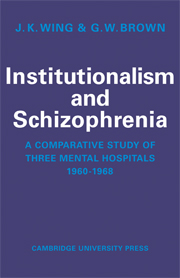Book contents
- Frontmatter
- Contents
- List of tables and figures
- Preface
- Acknowledgements
- 1 Disease and the social environment
- 2 The design of the study and methods of measurement
- 3 The three mental hospitals
- 4 The nature of institutionalism in mental hospitals
- 5 Differences between the hospitals in 1960
- 6 Changes in patients and environment, 1960–1964
- 7 Changes in the three hospitals compared, 1960–1968
- 8 The numerical data illustrated by a descriptive account of selected wards and representative patients
- 9 Comparative survey of schizophrenic patients in an American county hospital, 1964
- 10 Institutionalism and schizophrenia: summary, discussion and conclusions
- Tables and figures
- References
- Index
5 - Differences between the hospitals in 1960
Published online by Cambridge University Press: 04 August 2010
- Frontmatter
- Contents
- List of tables and figures
- Preface
- Acknowledgements
- 1 Disease and the social environment
- 2 The design of the study and methods of measurement
- 3 The three mental hospitals
- 4 The nature of institutionalism in mental hospitals
- 5 Differences between the hospitals in 1960
- 6 Changes in patients and environment, 1960–1964
- 7 Changes in the three hospitals compared, 1960–1968
- 8 The numerical data illustrated by a descriptive account of selected wards and representative patients
- 9 Comparative survey of schizophrenic patients in an American county hospital, 1964
- 10 Institutionalism and schizophrenia: summary, discussion and conclusions
- Tables and figures
- References
- Index
Summary
We assumed that there would be marked differences between the three hospitals in 1960, which the data concerning the total series of patients presented in Chapter 4 have obscured. The aims of the present chapter are, first, to describe the three social environments and, secondly, assuming that they do differ in important ways, to see whether there are equivalent clinical differences between the three groups of patients. We hypothesised that social poverty and clinical poverty should go together—but that, if anything, florid symptoms would be found in association with the most stimulating social conditions. Attitudes to discharge should be significantly related to length of stay at all three hospitals and there would be little difference between the three groups of patients in the proportion who wanted to leave.
AGE, LENGTH OF STAY AND OCCUPATION OF FATHERS
The composition of the three samples in respect of age and length of stay is set out in Tables 5.1 and 5.2 (p. 206).
The distributions are not significantly different at the three hospitals. However, since Mapperley tends to have more patients in the 51–60 age group, and more in the over-21 -years length-of-stay group, it will be necessary to allow for this in the subsequent analysis.
The occupation of the patients’ fathers was classified according to the system of Hall and Moser (1954), and differences between the three hospitals are shown in Table 5.3 (p. 207).
- Type
- Chapter
- Information
- Institutionalism and SchizophreniaA Comparative Study of Three Mental Hospitals 1960-1968, pp. 89 - 101Publisher: Cambridge University PressPrint publication year: 1970



